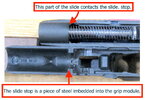Alllen Bundy
Member
I've transitioned from using standard pressure 9mm 115 gr ammo to Sig 124 gr +P ammo rated at 1,198 fps muzzle velocity for my Sig P365 and P365XL.
I've haven't had any malfunctions using the stock 17 lb recoil springs with any of the following standard pressure 9 mm 115 gr cartridges or 124 gr +P cartridges.
Browning Training & Practice - 115 gr FMJ - 1,190 fps
Magtech 9A - 115 gr FMJ - 1,135 fps
Remington Range - 115 gr FMJ - 1,145 fps
Winchester White Box - 115 gr FMJ - 1,190 fps
Speer LE Gold Dot Duty - 115 gr JHP - 1,210 fps
Sig Sauer Elite Performance - 115 gr JHP - 1,185 fps
Winchester Silver Tip - 115 gr JHP - 1,225 fps
=================
Sig Sauer M17 Nato - 124 gr FMJ +P - 1,198 fps
Sig Sauer M17 Nato - 124 gr JHP +P - 1,198 fps
But I'm wondering if it would be advisable to use a stronger recoil spring with the 124 gr +P ammo.
Recoils springs are available in strengths of 12, 14, 15, 16, 17, & 18 lb.
I've haven't had any malfunctions using the stock 17 lb recoil springs with any of the following standard pressure 9 mm 115 gr cartridges or 124 gr +P cartridges.
Browning Training & Practice - 115 gr FMJ - 1,190 fps
Magtech 9A - 115 gr FMJ - 1,135 fps
Remington Range - 115 gr FMJ - 1,145 fps
Winchester White Box - 115 gr FMJ - 1,190 fps
Speer LE Gold Dot Duty - 115 gr JHP - 1,210 fps
Sig Sauer Elite Performance - 115 gr JHP - 1,185 fps
Winchester Silver Tip - 115 gr JHP - 1,225 fps
=================
Sig Sauer M17 Nato - 124 gr FMJ +P - 1,198 fps
Sig Sauer M17 Nato - 124 gr JHP +P - 1,198 fps
But I'm wondering if it would be advisable to use a stronger recoil spring with the 124 gr +P ammo.
Recoils springs are available in strengths of 12, 14, 15, 16, 17, & 18 lb.


